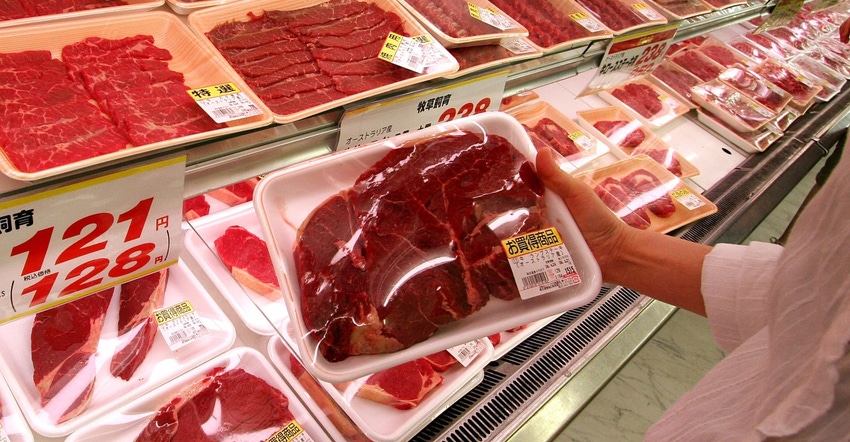Agreement increases safeguard provision to allow U.S. beef exports to remain competitive with other CPTPP nations.

U.S. Trade Representative Ambassador Katherine Tai signed a new agreement June 2 with Japan’s Ambassador to the United States Koji Tomita to revise the beef safeguard mechanism under the U.S.-Japan Trade Agreement. This updated agreement will amend the beef safeguard trigger level under the USJTA with a new, three-trigger safeguard mechanism. The agreement was finalized in March 2022, but not signed until this week.
USTR says the amendment will allow U.S. beef exporters to more reliably meet Japan’s growing demand for high-quality beef, providing more predictability and reducing the probability that safeguard duties would be imposed on U.S. beef, as occurred in early 2021. In 2021, the United States was the top beef exporting country in the world, with global sales of beef and beef products valued at over $10 billion. Exports of U.S. beef to Japan totaled almost $2.4 billion in 2021, with Japan representing the United States’ second largest beef export market.
“This agreement ensures that American farmers and ranchers can continue to meet Japan’s growing demand for high-quality U.S. beef while increasing market opportunities in a vital market,” says Tai. “I want to thank Secretary of Agriculture Tom Vilsack and Ambassador Rahm Emanuel for helping to get this agreement done. Together, the United States and Japan are demonstrating our commitment to working together on shared priorities to achieve concrete, economically meaningful results for our people.”
The agreement includes a new three-trigger mechanism whereby three criteria must be met in order for Japan to implement the safeguard and impose a temporary, higher tariff on U.S. beef. The three criteria are:
Imports from the United States must exceed the original beef safeguard trigger level under the U.S.-Japan Trade Agreement;
The aggregate volume of beef imports from the United States and the original signatories of the Comprehensive and Progressive Agreement for Trans-Pacific Partnership (CPTPP) must exceed the CPTPP beef safeguard; and
Imports from the United States must exceed the total amount of beef imports from the United States during the previous year. This third trigger will be in effect until 2027.
In March 2021, Japan and the U.S. entered negotiations after record-setting beef exports triggered the safeguard provision of the U.S.-Japan Trade Agreement. This increase in the Beef Safeguard Trigger level will allow American producers to continue exporting high-quality beef to meet Japanese consumer demand. U.S. beef exports to Japan exceeded 320,000 metric tons in 2021 and set a new value record at $2.38 billion. But U.S. beef was subject to a higher tariff than its competitors for 30 days, from mid-March to mid-April, after imports exceeded the safeguard volume.
“This agreement demonstrates how strong allies can work together to benefit each other – and it’s another example of how the Biden-Harris Administration is strengthening trade ties and creating new and better markets for our agricultural producers and exporters,” says Vilsack. “Japan is already the United States’ second-largest beef export market, and thanks to the work of Ambassador Tai and Ambassador Emanuel, our producers and exporters have greater opportunities and greater certainty that their products will not be subject to higher tariffs.”
“This deal is a win for America’s farmers and ranchers, and for Japan’s consumers,” adds Emanuel. “It allows us to build our share of a beef export market that was worth $2.4 billion in 2021, and since this agreement was announced, we’ve seen Japanese buyers boost their purchases of high-quality American beef by 30% over last year.”
The National Cattlemen’s Beef Association praised the agreement.
“The agreement signed today underscores the importance of the mutually beneficial relationship between U.S. cattle producers and Japanese consumers, and we are hopeful that the improved safeguard will provide greater certainty for all segments of the supply chain. NCBA thanks Ambassador Tai for her continued efforts to reduce trade barriers and expand export opportunities for American cattle producers,” says NCBA Senior Director of International Trade and Market Access Kent Bacus.
U.S. Meat Export Federation President and CEO Dan Halstrom noted when the agreement was first announced in March that the agreement was a tremendous breakthrough, but the playing field has not been entirely level due to this safeguard. “The changes announced today reduce the potential impact of the safeguard and make it less disruptive for U.S. exporters and their customers in Japan,”Halstrom says.
Following signature, both countries will follow their respective domestic procedures in order for the updated agreement to enter into force.
About the Author(s)
You May Also Like





